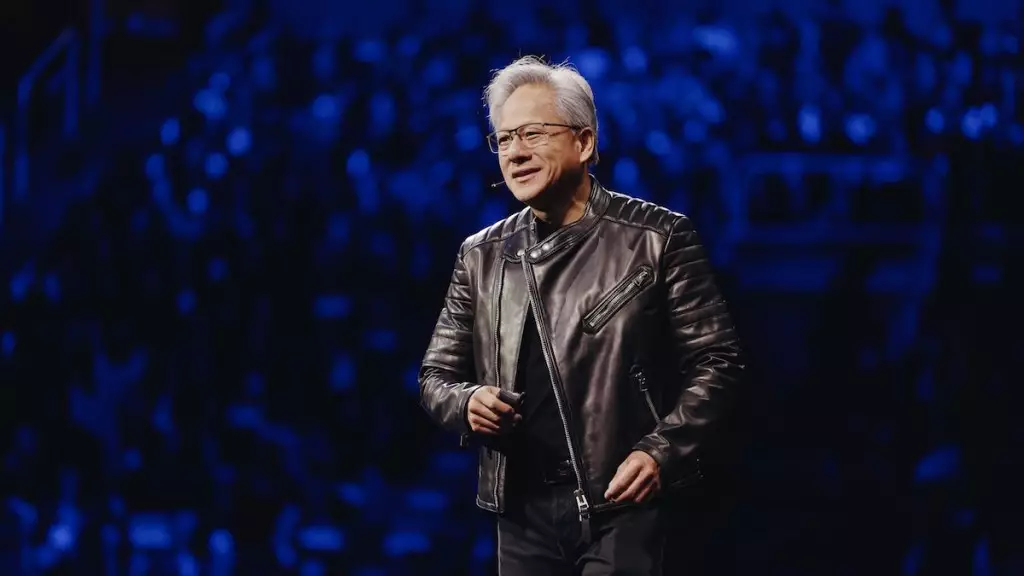The AI landscape is undergoing a radical transformation, characterized by a surge in the capabilities of artificial intelligence through expansive models that possess billions of parameters. NVIDIA, a titan in the tech sector led by its dynamic CEO Jensen Huang, is at the forefront of this revolution. During the recent GTC keynote, Huang elucidated the burgeoning demand for AI computing power, an urgent need driven by the transition from training models to full production inference. This shift is not merely incremental; it represents a paradigm shift where data centers are evolving into veritable AI factories, aimed at adeptly managing and processing millions of user queries.
The stakes of this transition are monumental, with an estimated market opportunity of $1 trillion on the horizon. NVIDIA’s aggressive advancements, showcased at GTC, signal an intense commitment to not just participate in but lead this revolution. The introduction of the Blackwell Ultra AI platform, along with a tailored operating system for optimizing AI-centric production environments, illustrates NVIDIA’s forward-thinking approach.
Blackwell: A Game-Changer in AI Performance
One of the standout revelations from Huang’s address was the performance leap brought by the Blackwell architecture. It is engineering marvels like Blackwell that exemplify a staggering 40 times performance increase over its predecessor, Hopper. Such advancements redefine how AI models are trained and inferred, paving the way for far more efficient and scalable AI applications. Expected to launch in the latter half of 2025, Blackwell Ultra is set to advance this trajectory even further, equipped with expanded memory capabilities tailored for the next wave of AI models. This continuous drive to innovate positions NVIDIA as a key player, setting the stage for an annual refresh of their AI architectures.
Moreover, the strategic release of robust GPUs, such as Vera Rubin, underscores NVIDIA’s mission to maximize the performance and efficiency of AI data centers. These innovations in GPU technology, combined with state-of-the-art photonics and AI-optimized storage solutions, promise to significantly reduce energy consumption—an essential factor as the demand for AI applications skyrockets.
Expanding Horizons in Robotics and Automation
The impact of NVIDIA’s innovations extends beyond computational prowess; they are also setting the groundwork for a new era of robotics and automation. Huang estimates that the potential market for physical AI stands at an astonishing $50 trillion, covering sectors from manufacturing to healthcare. NVIDIA’s Isaac and Cosmos platforms embody this shift, driving automation into new realms and showcasing the practical, life-altering implications of AI in various industries.
Crucial to this forward momentum is the forthcoming roadmap for NVIDIA’s hardware releases. The Vera Rubin series, set for the second half of 2026 and complementing versions in subsequent years, is designed with enhanced data transfer speeds. This quality becomes increasingly vital in grand AI systems that rely on multiple chips communicating rapidly and reliably.
Bridging the Connectivity Gap
As AI systems expand their reach, so too must the networking infrastructure that connects them. The Spectrum-X and Quantum-X networking platforms are positioned as indispensable tools in this regard, enabling AI factories to interconnect millions of GPUs across geographical expanses, all while significantly reducing energy expenditure. The release of Quantum-X Photonics InfiniBand switches provides a remarkable leap, while the introduction of Spectrum-X in 2026 promises even greater scalability and efficiency.
These networking advancements ensure that AI’s rapid evolution is matched by seamless connectivity, allowing organizations to harness the full power of their AI resources without the burden of enormous energy costs.
AI-Powered Innovations: A Vision for the Future
NVIDIA’s ambition doesn’t stop with hardware; it extends into the realm of software and research, propelling the AI narrative ever onwards. The introduction of open-source Dynamo software aims to enhance the speed and efficiency of multi-step reasoning processes, streamlining innovation in AI environments. This democratization of technology stands as a testament to NVIDIA’s philosophy that the tools of tomorrow should be accessible for all.
Additionally, initiatives like the NVIDIA Accelerated Quantum Research Center in Boston herald a collaborative approach to quantum computing, merging expertise from hardware and software domains. Ventures such as GR00T N1—a customizable foundational model for humanoid AI—underscores the holistic vision NVIDIA has for a future where machines can learn and adapt with human-like reasoning abilities.
The paradigm of AI is rapidly shifting, driven by a series of innovations that span across hardware, software, and applications, establishing NVIDIA not just as a leader, but as a catalyst in an unprecedented period of technological evolution.


Leave a Reply